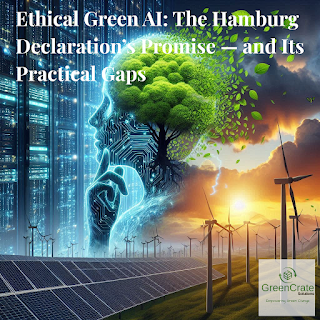Ethical Green AI: The Hamburg Declaration’s Promise—and Its Practical Gaps
1. Introduction – A Bold Vision, A Tough Reality
At the June 2025 Hamburg Sustainability Conference, global leaders united in endorsing the Hamburg Declaration on Responsible AI for the SDGs. It champions AI that’s equitable, sustainable, and people-centered—with goals spanning from climate resilience to biodiversity protection. undp.org
Yet, the document stops short of requiring renewable energy-powered AI data centers, binding environmental standards, funding mechanisms, or open-access requirements. That means aspirational rhetoric now meets hard questions:
-
How will AI hubs be powered sustainably and responsibly?
-
Who ensures and enforces these standards?
-
Who pays and who benefits from AI-driven sustainability?
-
Will this be open access or private profit?
This article explores both the promise and the friction points—and charts a path from vision to viable implementation.
2. What the Hamburg Declaration Actually Commits To
-
Transparency, inclusion, and climate alignment
-
Use of AI to support SDGs: biodiversity monitoring, agriculture, urban resilience, disaster warnings. eco-business.com
-
Improvement of resource efficiency, energy and water use, and e-waste protocols
-
Expansion of AI education and innovation in underserved regions, notably Africa. bmz-digital.global
Importantly, it does not mandate:
-
100% renewable energy for AI infrastructure
-
Public disclosure of energy use or funding
-
Open or shared access to AI tools beyond SDG commitments
3. Infrastructure Reality – The Hidden Cost
3.1. Energy Use Skyrocketing
-
Data center electricity demand is projected to double to ~945 TWh by 2030. statista.com
-
AI workloads accelerate this surge—potentially consuming more electricity than entire countries. iea.org
3.2. Energy vs. AI
-
A Google search uses ~0.3 Wh, while an AI request can consume 3–10× more
-
Large model training may involve hundreds of kilowatt-hours per run. news.ucsb.edu
3.3. Carbon & Growth
-
Data centers now account for 1–2% of global electricity, and are set to rise. arxiv.org
-
Emissions and fossil dependence are climbing in AI expansions. time.com
4. The Gaps: What the Declaration Leaves Unaddressed
4.1. Renewable Energy
Although the Declaration encourages "resource-efficient" AI and sustainable energy use, it lacks any mandatory renewable energy clause specifically for data centers.
4.2. Reporting & Transparency
It calls for better efficiency but doesn’t mandate public reporting of energy, water or emissions.
4.3. Funding & Access
No framework outlines who pays or how benefits are shared, nor whether SDG tools will be open-source or subscription-based.
5. Bridging Vision and Practical Reality
To bring the Declaration’s promises alive, these steps are essential:
5.1. Renewable Infrastructure
-
AI hubs must be powered by on-site renewables or linked via green energy PPAs
-
Examples: Meta’s geothermal plan in New Mexico and Amazon + RWE green PPA. reuters.com; reuters.com
5.2. Reporting and Certification
-
Public disclosure of PUE/CUE, water use and emissions
-
Independent auditors, green certification—like the Climate Neutral Data Centre Pact. en.wikipedia.org
5.3. Funding & Equitable Access
-
Pools from public, private, and donor sectors to fund green AI infrastructure
-
Open-source release of SDG solutions ensures global access, not corporate hoarding
5.4. Community and Benefit Sharing
-
Local consultation when planning new data hubs
-
Shared revenues or services for host communities—jobs, clean power, education
6. Critical Questions That Demand Answers
| Topic | Key Questions |
|---|---|
| Energy : | Will AI hubs run on renewables or fossil grids? |
| Transparency : | Where’s the data on energy, water, or emissions? |
| Funding : | Who pays? Tech, government, utilities, consumers? |
| Access : | Are SDG tools open or subscription-based? |
| Equity : | Who gains? Corporations… or local communities? |
7. Citizen Power: What You Can Do
-
Ask AI providers: "Are you powered by 100% renewables?"
-
Support policies requiring data center transparency and green standards
-
Push for open-source SDG-AI tools and shared benefit models
-
Advocate for community engagement when hubs set up locally
8. Conclusion – Move from Vision to Reality
The Hamburg Declaration sets an essential ethical compass—but its motors haven’t been turned on. To fulfill its promise, we must:
-
Mandate renewable energy usage
-
Require transparent environmental reporting
-
Fund sustainable infrastructure
-
Democratize access to climate tools
-
Center local communities in benefits and planning
AI can help build a resilient, equitable, sustainable future—but only if its infrastructure is held to the same environmental and ethical standards we wish it to serve.
Let’s turn the Declaration from words into action and AI from a tool into a true ally of the planet.



.png)
%20(1).png)
.png)
Comments
Post a Comment